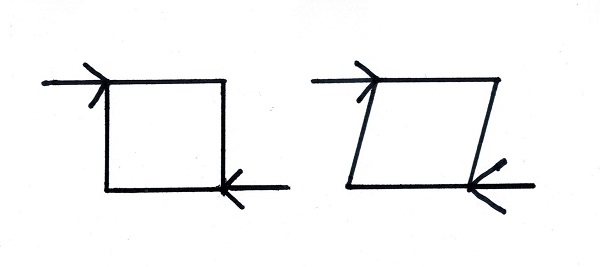Shear strength
Shear is a type of stress in which an applied force causes a structure to 'slide' in two or more directions. Shear can cause a structural member to split vertically or diagonally. For example, a cantilever beam built into a wall may shear at the point of support due either to its own weight or the applied forces, or both.
Shear strength is the ability of a material or component to resist shear forces without failing or, put another way, the maximum shear force that can be accommodated before failing.
Shear strength is analogous to ultimate tensile strength (UTS). The difference is that in shear the strain is parallel to the face (or cross-section) of the element in question whereas tensile strain is at right angles.
In structures, knowing the shear strength of materials is critical to be able to design or specify structural components (e.g beams, plates, bolts etc) economically whilst still withstanding shear forces.
In timber, shear strength tends to be affected by the direction of loading in relation to the grain. The shear strength tends to be around 10-15% of its tensile strength (in the direction of the grain). But shear strength will be reduced by the presence of knots, cracks and faults.
Adhesives tend to have high shear strengths. This can be measured by bonding two strips together then pulling them apart under a constant load. Typically, an epoxy resin adhesive can have shear strengths in the region of 26MPa, however, this is an idealised test and in use the shear strength of an adhesive can depend on many variables including surface preparation, conditions and so on.
Bolts can have a critical function in structures, for example, if they are used to connect a steel frame together or fix steel beams to a concrete core. In such instances, bolts may be required to withstand significant shear forces.
Typical shear strengths include:
In soil mechanics, the shear strength of soil is the shear force which can be sustained by the soil. This is dependent on numerous variables such as the friction between particles and the degree of interlock between them, whether they are cemented together or bonded at contact surfaces and so on.
Determining the shear strength of a cohesionless soil can be achieved by using either a direct shear test or a box shear test. Using the direct shear method allows the cohesion and angle of internal friction of soil to be established, which can be useful in the engineering design of elements such as foundations and retaining walls.
The direct shear test can be applied to the following soil conditions:
- Unconsolidated-undrained.
- Consolidated-undrained.
- Consolidated-drained.
See also: Shear.
[edit] Related articles on Designing Buildings Wiki
Featured articles and news
RTPI leader to become new CIOB Chief Executive Officer
Dr Victoria Hills MRTPI, FICE to take over after Caroline Gumble’s departure.
Social and affordable housing, a long term plan for delivery
The “Delivering a Decade of Renewal for Social and Affordable Housing” strategy sets out future path.
A change to adoptive architecture
Effects of global weather warming on architectural detailing, material choice and human interaction.
The proposed publicly owned and backed subsidiary of Homes England, to facilitate new homes.
How big is the problem and what can we do to mitigate the effects?
Overheating guidance and tools for building designers
A number of cool guides to help with the heat.
The UK's Modern Industrial Strategy: A 10 year plan
Previous consultation criticism, current key elements and general support with some persisting reservations.
Building Safety Regulator reforms
New roles, new staff and a new fast track service pave the way for a single construction regulator.
Architectural Technologist CPDs and Communications
CIAT CPD… and how you can do it!
Cooling centres and cool spaces
Managing extreme heat in cities by directing the public to places for heat stress relief and water sources.
Winter gardens: A brief history and warm variations
Extending the season with glass in different forms and terms.
Restoring Great Yarmouth's Winter Gardens
Transforming one of the least sustainable constructions imaginable.
Construction Skills Mission Board launch sector drive
Newly formed government and industry collaboration set strategy for recruiting an additional 100,000 construction workers a year.
New Architects Code comes into effect in September 2025
ARB Architects Code of Conduct and Practice available with ongoing consultation regarding guidance.
Welsh Skills Body (Medr) launches ambitious plan
The new skills body brings together funding and regulation of tertiary education and research for the devolved nation.
Paul Gandy FCIOB announced as next CIOB President
Former Tilbury Douglas CEO takes helm.
UK Infrastructure: A 10 Year Strategy. In brief with reactions
With the National Infrastructure and Service Transformation Authority (NISTA).























